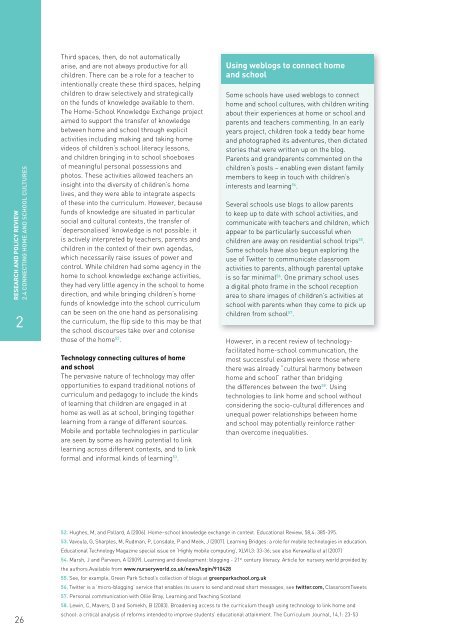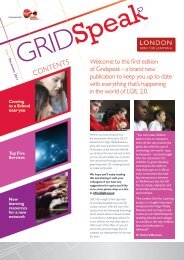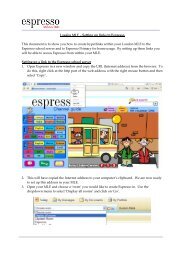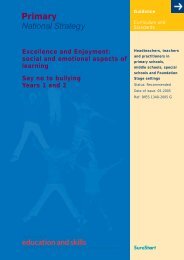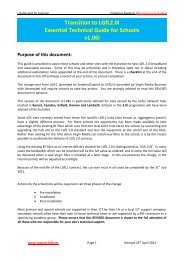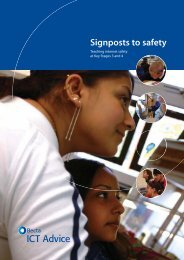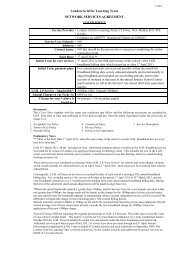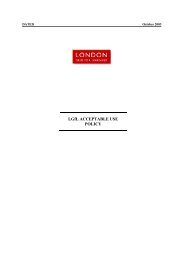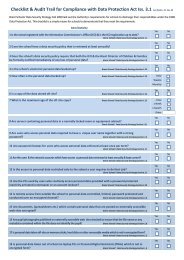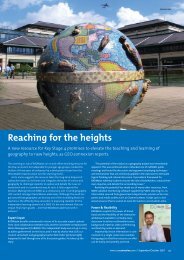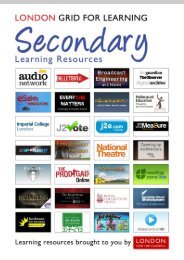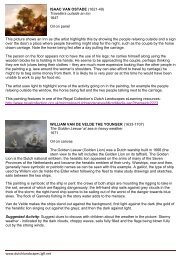Developing the home-school relationship using digital ... - Futurelab
Developing the home-school relationship using digital ... - Futurelab
Developing the home-school relationship using digital ... - Futurelab
- No tags were found...
Create successful ePaper yourself
Turn your PDF publications into a flip-book with our unique Google optimized e-Paper software.
RESEARCH AND POLICY REVIEW2.4 CONNECTING HOME AND SCHOOL CULTURES2Third spaces, <strong>the</strong>n, do not automaticallyarise, and are not always productive for allchildren. There can be a role for a teacher tointentionally create <strong>the</strong>se third spaces, helpingchildren to draw selectively and strategicallyon <strong>the</strong> funds of knowledge available to <strong>the</strong>m.The Home-School Knowledge Exchange projectaimed to support <strong>the</strong> transfer of knowledgebetween <strong>home</strong> and <strong>school</strong> through explicitactivities including making and taking <strong>home</strong>videos of children’s <strong>school</strong> literacy lessons,and children bringing in to <strong>school</strong> shoeboxesof meaningful personal possessions andphotos. These activities allowed teachers aninsight into <strong>the</strong> diversity of children’s <strong>home</strong>lives, and <strong>the</strong>y were able to integrate aspectsof <strong>the</strong>se into <strong>the</strong> curriculum. However, becausefunds of knowledge are situated in particularsocial and cultural contexts, <strong>the</strong> transfer of‘depersonalised’ knowledge is not possible: itis actively interpreted by teachers, parents andchildren in <strong>the</strong> context of <strong>the</strong>ir own agendas,which necessarily raise issues of power andcontrol. While children had some agency in <strong>the</strong><strong>home</strong> to <strong>school</strong> knowledge exchange activities,<strong>the</strong>y had very little agency in <strong>the</strong> <strong>school</strong> to <strong>home</strong>direction, and while bringing children’s <strong>home</strong>funds of knowledge into <strong>the</strong> <strong>school</strong> curriculumcan be seen on <strong>the</strong> one hand as personalising<strong>the</strong> curriculum, <strong>the</strong> flip side to this may be that<strong>the</strong> <strong>school</strong> discourses take over and colonisethose of <strong>the</strong> <strong>home</strong> 52 .Technology connecting cultures of <strong>home</strong>and <strong>school</strong>The pervasive nature of technology may offeropportunities to expand traditional notions ofcurriculum and pedagogy to include <strong>the</strong> kindsof learning that children are engaged in at<strong>home</strong> as well as at <strong>school</strong>, bringing toge<strong>the</strong>rlearning from a range of different sources.Mobile and portable technologies in particularare seen by some as having potential to linklearning across different contexts, and to linkformal and informal kinds of learning 53 .Using weblogs to connect <strong>home</strong>and <strong>school</strong>Some <strong>school</strong>s have used weblogs to connect<strong>home</strong> and <strong>school</strong> cultures, with children writingabout <strong>the</strong>ir experiences at <strong>home</strong> or <strong>school</strong> andparents and teachers commenting. In an earlyyears project, children took a teddy bear <strong>home</strong>and photographed its adventures, <strong>the</strong>n dictatedstories that were written up on <strong>the</strong> blog.Parents and grandparents commented on <strong>the</strong>children’s posts – enabling even distant familymembers to keep in touch with children’sinterests and learning 54 .Several <strong>school</strong>s use blogs to allow parentsto keep up to date with <strong>school</strong> activities, andcommunicate with teachers and children, whichappear to be particularly successful whenchildren are away on residential <strong>school</strong> trips 55 .Some <strong>school</strong>s have also begun exploring <strong>the</strong>use of Twitter to communicate classroomactivities to parents, although parental uptakeis so far minimal 56 . One primary <strong>school</strong> usesa <strong>digital</strong> photo frame in <strong>the</strong> <strong>school</strong> receptionarea to share images of children’s activities at<strong>school</strong> with parents when <strong>the</strong>y come to pick upchildren from <strong>school</strong> 57 .However, in a recent review of technologyfacilitated<strong>home</strong>-<strong>school</strong> communication, <strong>the</strong>most successful examples were those where<strong>the</strong>re was already “cultural harmony between<strong>home</strong> and <strong>school</strong>” ra<strong>the</strong>r than bridging<strong>the</strong> differences between <strong>the</strong> two 58 . Usingtechnologies to link <strong>home</strong> and <strong>school</strong> withoutconsidering <strong>the</strong> socio-cultural differences andunequal power <strong>relationship</strong>s between <strong>home</strong>and <strong>school</strong> may potentially reinforce ra<strong>the</strong>rthan overcome inequalities.2652. Hughes, M, and Pollard, A (2006). Home–<strong>school</strong> knowledge exchange in context. Educational Review, 58,4: 385-395.53. Vavoula, G, Sharples, M, Rudman, P, Lonsdale, P and Meek, J (2007). Learning Bridges: a role for mobile technologies in education.Educational Technology Magazine special issue on ‘Highly mobile computing’, XLVII,3: 33-36; see also Kerawalla et al (2007)54. Marsh, J and Parveen, A (2009). Learning and development: blogging - 21 st century literacy. Article for nursery world provided by<strong>the</strong> authors.Available from www.nurseryworld.co.uk/news/login/91042855. See, for example, Green Park School’s collection of blogs at greenpark<strong>school</strong>.org.uk56. Twitter is a ‘micro-blogging’ service that enables its users to send and read short messages, see twitter.com, ClassroomTweets57. Personal communication with Ollie Bray, Learning and Teaching Scotland58. Lewin, C, Mavers, D and Somekh, B (2003). Broadening access to <strong>the</strong> curriculum though <strong>using</strong> technology to link <strong>home</strong> and<strong>school</strong>: a critical analysis of reforms intended to improve students’ educational attainment. The Curriculum Journal, 14,1: 23-53


